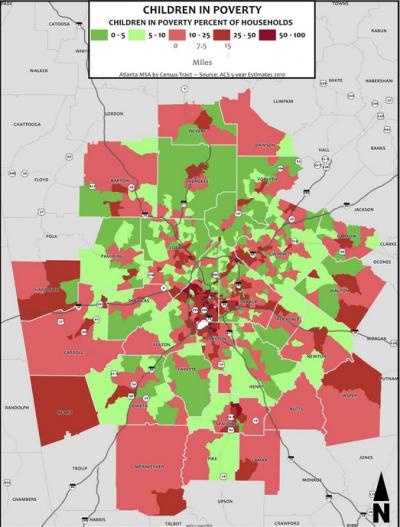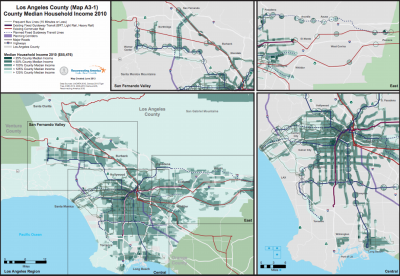
Metro Atlanta Equity Atlas
The Metro Atlanta Equity Atlas (MAEA), created by the Partnership for Southern Equity, was designed to connect local stakeholders to timely, accurate data about the state of the region.
The MAEA includes over 200 maps examining eight key areas of community well-being (demographics, economic development, education, environment, health, housing, public safety, and transportation). The equity atlas covers a 28-county region, and most of the maps display the data at a county level. All of the maps are static maps that can be viewed online or downloaded as PDFs. The maps are organized by topic and type, making the equity atlas relatively easy to navigate and understand.
The MAEA maps are accompanied by a report that analyzes each of the eight categories of community well-being based on the maps, along with policy change recommendations.
The Los Angeles Equity Atlas
The Los Angeles Equity Atlas, a project of Reconnecting America and the California Community Foundation, was developed to help inform the expansion of Los Angeles County’s regional transit system. The equity atlas overlays the transit network on different measures to help identify the key assets and gaps in individual communities in relationship to station areas and transit lines.

The equity atlas includes 65 maps organized into four themes: (1) increasing mobility, access and connectivity, (2) preserving and creating affordable housing, and managing neighborhood change, (3) supporting economic and workforce development, and (4) investing in healthy communities.
The Los Angeles Equity Atlas maps encompass a single county (Los Angeles County), focusing on four county sub-areas. Most of the maps display the data at a high level of geographic resolution (block groups, points, etc.).
The maps can be viewed online or downloaded as PDFs. They are organized as part of a broader report that uses the maps to illustrate and support a series of desired outcomes and recommendations related to each of the four themes. This makes the maps easy to navigate and understand, and makes the equity atlas as a whole very action oriented.

